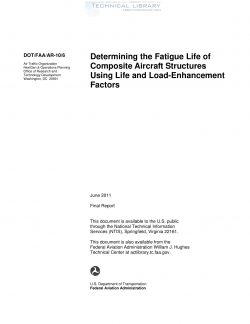DOT-FAA-AR-10-6
- Version
- 1168 Downloads
- 4.77 MB File Size
- 1 File Count
- March 5, 2017 Create Date
- March 5, 2017 Last Updated
Determining the Fatigue Life of Composite Aircraft Structures Using Life and Load-Enhancement Factors

Over the past 25 years, the use Of advanced composite materials in aircraft primary structures has increased significantly. In 1994, with the Advanced General Aviation Transport Experiments program, the National Aeronautics and Space Administration and the Federal Aviation Administration revitalized the use Of composites in general and commercial aviation. Driven by the demand for fuel-efficient, light-weight, and high-stiffness Structures that have fatigue durability and corrosion resistance, modern large commercial aircraft are designed with more than 50 percent composite materials. Although there are key differences between metal and composite damage mechanics and durability concerns, the certification philosophy for composites must meet the same structural integrity, safety, and durability requirements as that Of metals. Despite the many advantages, composite structural certification becomes challenging due to the lack Of experience in large-scale structures, complex interactive failure mechanisms, sensitivity to temperature and moisture, and scatter in the data, especially in fatigue. The overall objective Of this research was to provide guidance into structural substantiation Of composite airframe structures under repeated loads through an efficient approach that weighs both the economic aspects of certification and the timeframe required for testing, while ensuring safety. The research methodology reported here consisted Of combining existing certification approaches used by various aircraft manufacturers with protocols for applying these methodologies. This will permit extension Of the methodologies to new material systems and construction techniques. This study included data for materials commonly used in aircraft applications, including adhesives and sandwich construction. Testing consisted Of various element-type tests and concentrated on tests that were generic in nature and were representative Of various loading modes and construction techniques. In addition, the database available at the National Institute Of Aviation Research was included to expand the data for the scatter analysis. Three different techniques were used for scatter analysis Of fatigue data: individual Weibull, joint Weibull, and the Sendeckyj wearout model. Procedures to generate reliable and economical scatter and load- enhancement factors necessary for a particular structural test by selecting the design details representing the critical areas Of the structure is outlined with several examples and case studies. The effects Of laminate stacking sequence, test environment, stress ratios, and several design features, such as sandwich and bonded joints on the static-strength and fatigue-life shape parameters, are discussed with detailed examples. Furthermore, several analytical techniques for obtaining these shape parameters are discussed with examples. Finally, the application Of load- enhancement factors and life factors for a full-scale test spectrum without adversely affecting the fatigue life and the damage mechanism Of the composite Structure is discussed.
| File | Action |
|---|---|
| DOT-FAA-AR-10-6 Determining the Fatigue Life of Composite Aircraft Structures Using Life and Load-Enhancement Factors.pdf | Download |

Comment On This Post